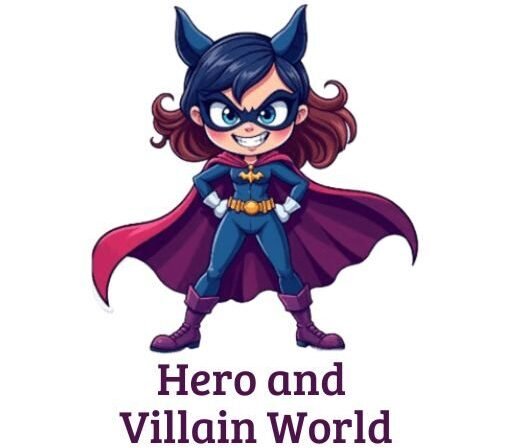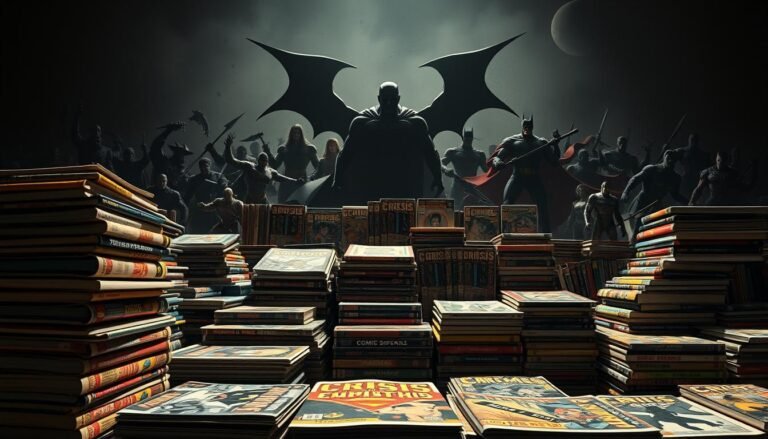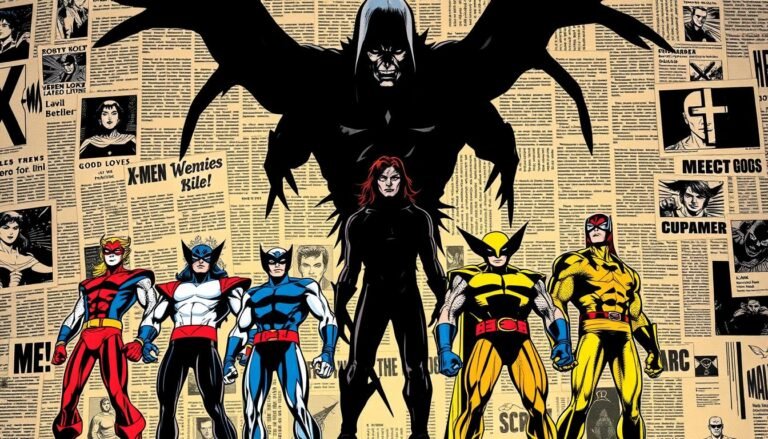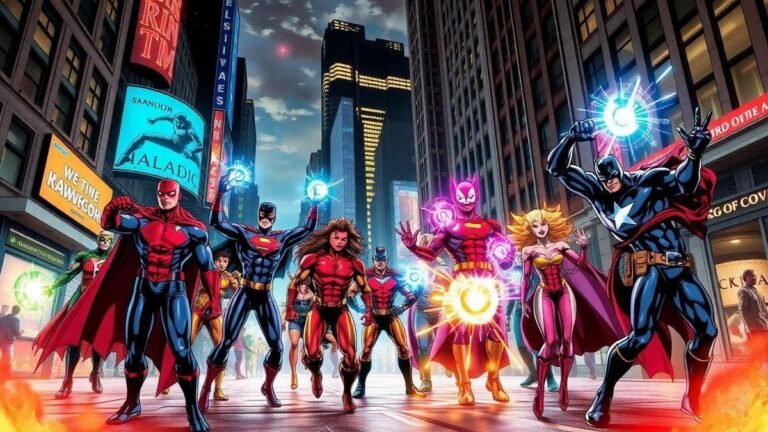Black Panther vs. Killmonger: A Fight for Wakanda’s Soul
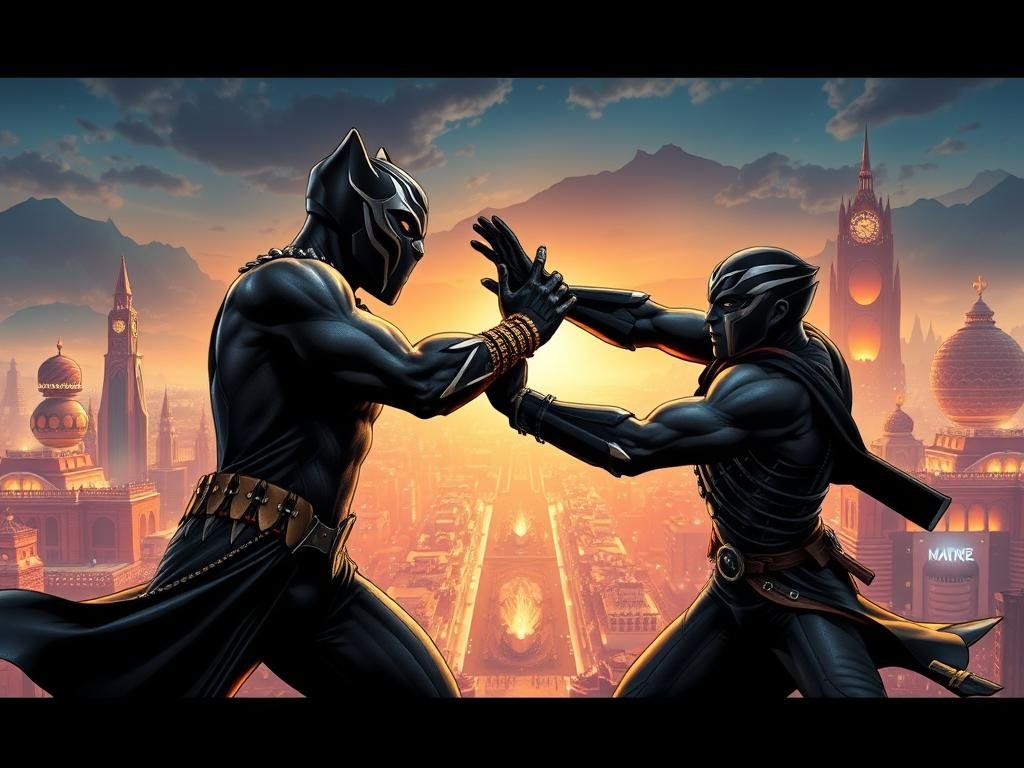
I still remember the first time I witnessed the epic clash between T’Challa and Erik Killmonger. Their battle was more than just a physical fight; it was a clash of ideologies that shook the very foundations of Wakanda.
The rivalry between these two characters represents a deeper struggle between tradition and progress. On one hand, T’Challa embodies the legacy of Wakanda, while on the other, Killmonger seeks to revolutionize the nation’s role in the world.
This conflict has captivated comic book fans for decades, raising important questions about the responsibility that comes with power and the true meaning of liberation.
The Epic Rivalry That Defined Wakanda
Wakanda’s most significant conflict revolves around the ideological battle between its king, Black Panther, and his challenger, Erik Killmonger.
This rivalry is not just about a fight for the throne; it represents the central tension in Wakanda’s history – whether to remain isolated or engage with the outside world.
The conflict between Black Panther, also known as T’Challa, and Erik Killmonger has shaped not just the characters but the entire fictional nation of Wakanda and its place in the Marvel universe.
Both characters have legitimate claims to the throne and compelling visions for Wakanda’s future, making this conflict particularly nuanced.
Throughout comic history, there have been key moments where this rivalry reached critical points, changing the trajectory of Wakandan storylines.
For instance, Erik Killmonger‘s challenge to T’Challa for the throne brought to the forefront the debate on whether Wakanda should use its advanced technology to help oppressed people worldwide.
| Aspect | Black Panther’s Vision | Erik Killmonger’s Vision |
|---|---|---|
| Global Engagement | Prefers isolationism, cautious about global involvement | Advocates for using Wakanda’s technology to aid oppressed people globally |
| Claim to the Throne | Rightful king by birthright | Claims the throne based on his ancestral lineage and Wakandan heritage |
This rivalry explores themes of colonialism, isolationism, responsibility, and heritage, giving it depth beyond typical superhero rivalries. As the King of Wakanda, Black Panther must navigate these complex issues while facing challengers like Erik Killmonger.
The Creative Minds Behind the Conflict
The Black Panther and Killmonger saga is a testament to the creative genius of the individuals who conceived and developed their narratives. The epic rivalry between these two characters has been shaped by numerous talented creators over the years.
Stan Lee and Jack Kirby’s Vision
Stan Lee and Jack Kirby are renowned for introducing Black Panther to the world in Fantastic Four #52 (1966). Their initial portrayal of T’Challa and Wakanda laid the groundwork for the rich history and complex world that followed.
Lee’s knack for creating compelling characters and Kirby’s iconic artwork brought depth and visual grandeur to the narrative.
Although Killmonger was not introduced until much later, the foundation laid by Lee and Kirby was crucial in making Wakanda a central part of the Marvel Universe.
Don McGregor’s Contribution
Don McGregor’s “Panther’s Rage” storyline in the 1970s was pivotal in expanding Black Panther’s world and introducing Erik Killmonger.
McGregor’s work not only brought a more complex political landscape to Wakanda but also established the central conflict between isolation and intervention.
His storytelling approach introduced more sophisticated themes to the character, laying the groundwork for the ideological differences between T’Challa and Killmonger.
McGregor’s contributions remain influential in all subsequent Black Panther stories across comics and other media.
| Creator | Contribution | Impact |
|---|---|---|
| Stan Lee and Jack Kirby | Introduced Black Panther and Wakanda | Laid the groundwork for Wakanda’s rich history |
| Don McGregor | Introduced Erik Killmonger and expanded Wakanda’s political landscape | Established the central conflict between isolation and intervention |
The table highlights the significant roles these creators played in shaping the Black Panther and Killmonger narrative. Their work has had a lasting impact on the Marvel Universe, making the conflict between Black Panther and Killmonger a compelling and complex saga.
Origin Story: The Birth of a Rivalry
To comprehend the intensity of the Black Panther and Killmonger confrontation, one must delve into their origin stories. The paths that T’Challa and N’Jadaka, aka Killmonger, took in their lives set the stage for their monumental clash.
T’Challa’s Royal Heritage
T’Challa, the son of King T’Chaka, was born into a life of royalty in Wakanda. From a young age, he was groomed to take over the throne, receiving training in combat, politics, and leadership.
His connection to the Heart-Shaped Herb and the Black Panther mantle is deeply rooted in his heritage, making him a symbol of Wakanda’s strength and unity.
N’Jadaka’s Path to Becoming Killmonger
N’Jadaka, on the other hand, had a very different journey. After witnessing his father’s death, N’Jadaka was raised in Oakland, California, far from Wakanda.
His early life was marked by hardship and a sense of abandonment. Despite these challenges, he excelled academically, attending prestigious institutions like the Naval Academy and MIT.
His academic prowess and determination led him to join the Navy SEALs, where he became known as Erik Killmonger due to his exceptional combat skills and high kill count in operations across the globe.
For more insights into characters like Killmonger, you can explore resources such as The American Villain Encyclopedia.
Killmonger’s life was a calculated preparation for his return to Wakanda, driven by a desire to claim his birthright and challenge the status quo. Every step of his journey, from his military career to his ideological alignment, was geared towards this ultimate goal.
First Confrontation: When Black Panther Met Killmonger
The initial fight between Black Panther and Killmonger was a test of strength, strategy, and ideology, setting the stage for their legendary rivalry.
Their first encounter took place in Jungle Action #6 (1973), a comic book issue that marked a significant moment in the history of Wakanda. To understand the context of this confrontation, it’s essential to delve into the details of this comic book issue.
Jungle Action #6 (1973)
In Jungle Action #6 (1973), T’Challa, as Black Panther, faced off against N’Jadaka, who would later become known as Killmonger. This comic book issue laid the groundwork for the complex relationship between these two characters, introducing the contrasting ideologies that would fuel their battle for control of Wakanda.
The Initial Battle for Wakanda
The Killmonger T’Challa confrontation was not just a physical clash but also an ideological one. T’Challa’s traditional Wakandan combat techniques were pitted against Killmonger’s military training, showcasing their different approaches to achieving their goals.
The stakes were high, with the future of Wakanda hanging in the balance. This initial confrontation established patterns that would repeat in their future encounters, as both characters stood to gain or lose significant advantages.
The aftermath of the fight had a lasting impact on both T’Challa and Killmonger, influencing their trajectories in the comics and shaping the destiny of Wakanda.
The consequences of their clash resonated throughout the kingdom, affecting not just the characters involved but also the broader narrative of Wakanda’s struggle for identity and power.
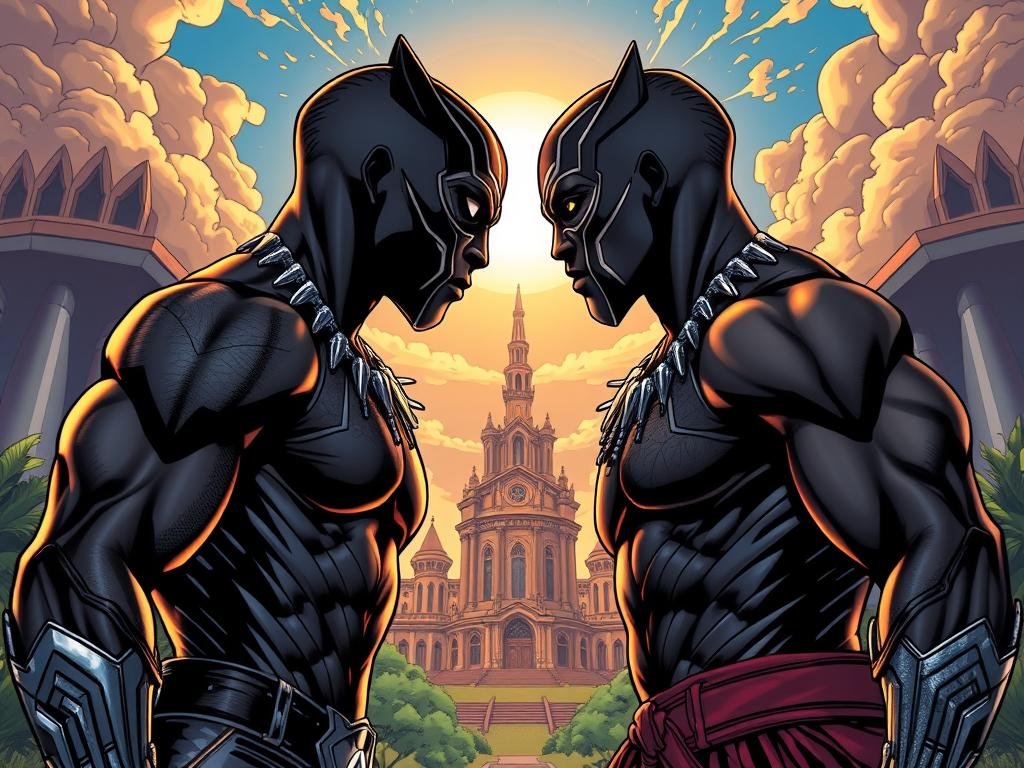
Comic Book Appearances Through the Years
From classic storylines to modern interpretations, the Black Panther and Killmonger rivalry continues to captivate readers. Their conflict has been a significant part of Wakandan comic book history, evolving over the decades to reflect changing societal values and political climates.
Classic Storylines
The original confrontation between Black Panther and Killmonger, as seen in Jungle Action #6 (1973), laid the groundwork for their complex rivalry.
This initial storyline introduced the core themes of their conflict, including colonialism, identity, and the struggle for power in Wakanda.
The creative vision of Stan Lee and Jack Kirby, combined with the storytelling of Don McGregor, established a rich narrative that has been built upon over the years.
As noted by comic book historian, “The introduction of Killmonger marked a significant shift in Black Panther’s narrative, adding depth to the character and the world of Wakanda.”
This classic storyline has been revisited and reimagined in various forms, showcasing the enduring appeal of the characters and their conflict.
Modern Interpretations
In recent years, the Black Panther and Killmonger rivalry has been recontextualized for contemporary readers, particularly through Ta-Nehisi Coates’ acclaimed run on Black Panther.
Coates’ storytelling explored nuanced political themes through the T’Challa/Killmonger dynamic, delving into issues such as global inequality, historical trauma, and the complexities of power.
As Coates himself noted, “The conflict between T’Challa and Killmonger is not just about personal vendetta, but about the very soul of Wakanda.”
Modern comics have also been influenced by the characters’ popularity in the MCU, while maintaining their comic book roots.
The visual reimagining of both characters by modern artists has honored their classic designs while introducing fresh perspectives.
The rivalry continues to be used to explore relevant social and political issues, ensuring its continued relevance in contemporary comic book discourse. For more on powerful Marvel heroes, you can check out this article.
Key Characters in the Black Panther vs. Killmonger Saga
The battle for Wakanda’s future is influenced by a multitude of characters, each with their own motivations and allegiances.
The conflict between Black Panther and Killmonger is not just about the two protagonists; it’s about the intricate web of relationships and loyalties that define Wakandan society.

The Royal Family of Wakanda
The royal family is at the heart of Wakanda’s politics and plays a significant role in the Black Panther vs. Killmonger saga.
T’Challa, as the king, is the central figure around whom the conflict revolves. His sister, Shuri, brings a unique perspective with her technological prowess, often providing crucial support to T’Challa.
The Dora Milaje, Wakanda’s elite female warriors, serve as the king’s bodyguards and special forces, navigating their loyalty to the throne regardless of who sits upon it.
Killmonger’s Allies
Killmonger, or N’Jadaka, has his own set of allies who are instrumental in his quest for power. Ulysses Klaue, a notorious black market arms dealer, forms an alliance with Killmonger, providing him with the resources needed to challenge T’Challa.
The Dora Milaje are also tested when Killmonger takes the throne, forcing them to reconcile their duty with their moral compass.
Supporting Characters
Several supporting characters add depth to the narrative, including tribal leaders and council members who represent different factions within Wakandan society.
International characters become involved in Wakandan affairs, bringing external pressures to bear on the conflict. The Dora Milaje again play a crucial role, as their position demands loyalty to the throne, illustrating the complexity of their position in the conflict.
These characters provide different perspectives on the central ideological debate between Black Panther and Killmonger, enriching the story and highlighting the multifaceted nature of Wakanda’s internal struggles.
Historical Context: When These Stories Were Written
As I delve into the comic book series, it becomes clear that the era in which these stories were written played a significant role in shaping the narrative.
The Black Panther vs. Killmonger conflict is a prime example of how comic book storylines can reflect and comment on the social and political issues of their time.
1970s Political Climate
The original comic book series featuring Black Panther and Killmonger emerged during the 1970s, a decade marked by significant social change and political unrest in the United States.
The Civil Rights Movement was still gaining momentum, and issues of racial identity, equality, and justice were at the forefront of public discourse.
The storyline drew inspiration from these themes, with Killmonger’s character, in particular, representing a radical response to the perceived failures of the existing social order.
The content of these early comics laid the groundwork for the complex ideological debates that would come to define the rivalry.
Evolution Through Different Eras
As the decades passed, the Black Panther vs. Killmonger narrative evolved, reflecting changing societal attitudes and global events.
The 1990s saw a more globalized perspective introduced under Christopher Priest’s influential run, which expanded Wakanda’s role on the world stage.
Post-9/11 comics addressed themes of security, intervention, and responsibility, resonating with the central conflict. By the 2010s, the storyline had come to focus on questions of diaspora identity and international responsibility, adding new dimensions to the rivalry while maintaining its core ideological tension.
This evolution allowed the characters to rest on a foundation of depth and complexity, making their conflict all the more compelling.
The ongoing evolution of the Black Panther vs. Killmonger storyline demonstrates the dynamic nature of comic book narratives, which can adapt to reflect the changing world around us.
By understanding the historical context in which these stories were written, readers can gain a deeper appreciation for the themes and issues that drive the plot.
Black Panther vs. Killmonger: A Fight for Wakanda’s Soul
The rivalry between Black Panther and Killmonger is a tale of contrasting visions for Wakanda’s future. At its core, their conflict is not just about physical strength or martial prowess, but about the very soul of Wakanda.
The Ideological Battle
Killmonger, also known as N’Jadaka, believed that Wakanda should utilize its advanced technology to aid oppressed people worldwide, rather than maintaining its historical isolationism.
This stance directly contrasts with T’Challa’s more cautious approach, who advocates for a gradual and controlled opening of Wakanda to the world. Their ideological battle is a reflection of broader debates about globalization, responsibility, and the role of powerful nations or entities in global affairs.
Their differences are highlighted in the following key areas:
- Global Intervention: Killmonger supported using Wakanda’s resources to actively fight against oppression globally.
- Isolationism vs. Engagement: T’Challa preferred a more measured approach, focusing on strengthening Wakanda internally before extensive global engagement.
- Methods of Achieving Change: Killmonger’s methods were often violent and revolutionary, whereas T’Challa advocated for more diplomatic and strategic actions.
The Physical Confrontations
The physical battles between Black Panther and Killmonger are legendary, showcasing not only their martial skills but also their strategic thinking and willpower. Their combat is deeply rooted in Wakandan traditions, respecting the ritualistic aspects of their confrontation.
The most significant physical confrontations include:
- The initial battle for the Wakandan throne, where Killmonger challenged T’Challa’s right to rule.
- Subsequent fights in various comic issues, highlighting their different fighting styles and strategic approaches.
The outcomes of these battles have significant consequences for Wakanda, impacting its internal politics and external relations.
Even in physical combat, the ideological dimensions of their conflict remain central, reflecting the complex interplay between personal conviction, cultural heritage, and the future of a nation.
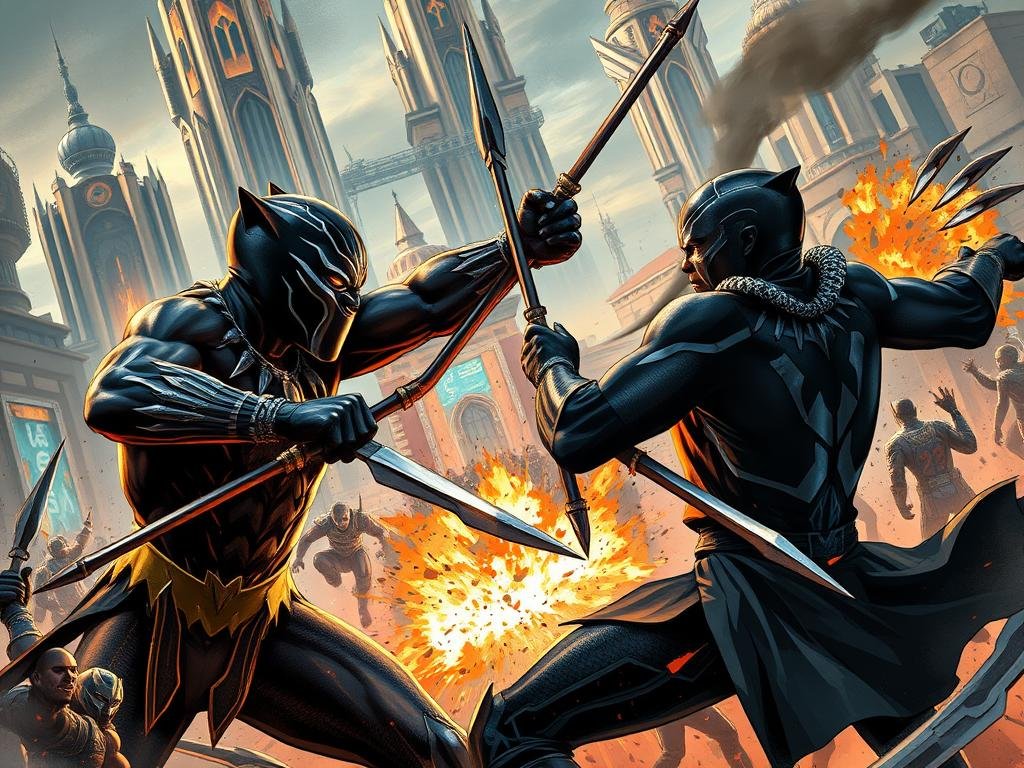
Their fight is a fair one, with both characters giving their all. It’s a testament to the strength and resilience of Wakanda that such conflicts can occur without destroying the nation, instead serving as a catalyst for growth and change.
Strengths and Weaknesses Analysis
In the epic struggle between Black Panther and Killmonger, understanding their strengths and weaknesses is crucial to grasping the complexity of their conflict.
This analysis will delve into the tactical brilliance of T’Challa and the raw power of Killmonger, examining how their different philosophies influence their strategies.
Tactical Brilliance vs. Raw Power
T’Challa’s commitment to Wakandan traditions and values provides him with moral clarity, but sometimes limits his tactical options.
For instance, his adherence to a fair fight can be seen as a strategic disadvantage against an opponent like Killmonger, who has no such qualms. In contrast, Killmonger’s willingness to use any means necessary gives him tactical flexibility, but at the risk of moral compromise.
Philosophical Differences as Strategic Advantages
The philosophical differences between T’Challa and Killmonger significantly impact their approach to leadership and gaining allies.
T’Challa’s emphasis on tradition and the well-being of Wakanda attracts allies who value stability and heritage. On the other hand, Killmonger’s revolutionary ideology and promise of global change appeal to those seeking a new way forward, giving him an advantage in certain contexts.
Their worldviews shape not just what they fight for, but how they fight, influencing the outcome of their confrontation.
By analyzing these aspects, it becomes clear that the conflict between Black Panther and Killmonger is as much about ideological differences as it is about physical strength or tactical prowess.
Their strategies are deeply rooted in their beliefs, making their rivalry a multifaceted and compelling narrative.
Critical Reception and Cultural Impact
The conflict between Black Panther and Killmonger has become a focal point for discussions on ideology and identity. This rivalry has not only captivated comic book fans but has also sparked meaningful conversations across various platforms.
The reception of the Black Panther vs. Killmonger storyline has evolved significantly since its introduction. Initially, fans were divided on Killmonger’s radical methods, but over time, his complex character has garnered a significant following.
Scholarly Analysis
Scholars have analyzed the Black Panther vs. Killmonger conflict through various lenses, including postcolonial theory and critical race theory.
The ideological battle between T’Challa’s traditionalism and Killmonger’s revolutionary zeal has been a particular point of interest. This dichotomy raises important questions about identity, power, and responsibility.
Fan Reception Through the Decades
Fan reception of the Black Panther vs. Killmonger rivalry has transformed over the years, influenced by changing social and political landscapes. Here are some key aspects of this evolution:
- Fans have increasingly engaged with the ideological dimensions of the conflict, debating the merits of T’Challa’s and Killmonger’s approaches.
- Social media has played a crucial role in shaping these discussions, providing platforms for fans to share their interpretations and analyses.
- The Marvel Cinematic Universe’s portrayal of the conflict in “Black Panther” (2018) introduced this narrative to a new generation of fans, sparking renewed interest in the comic book origins.
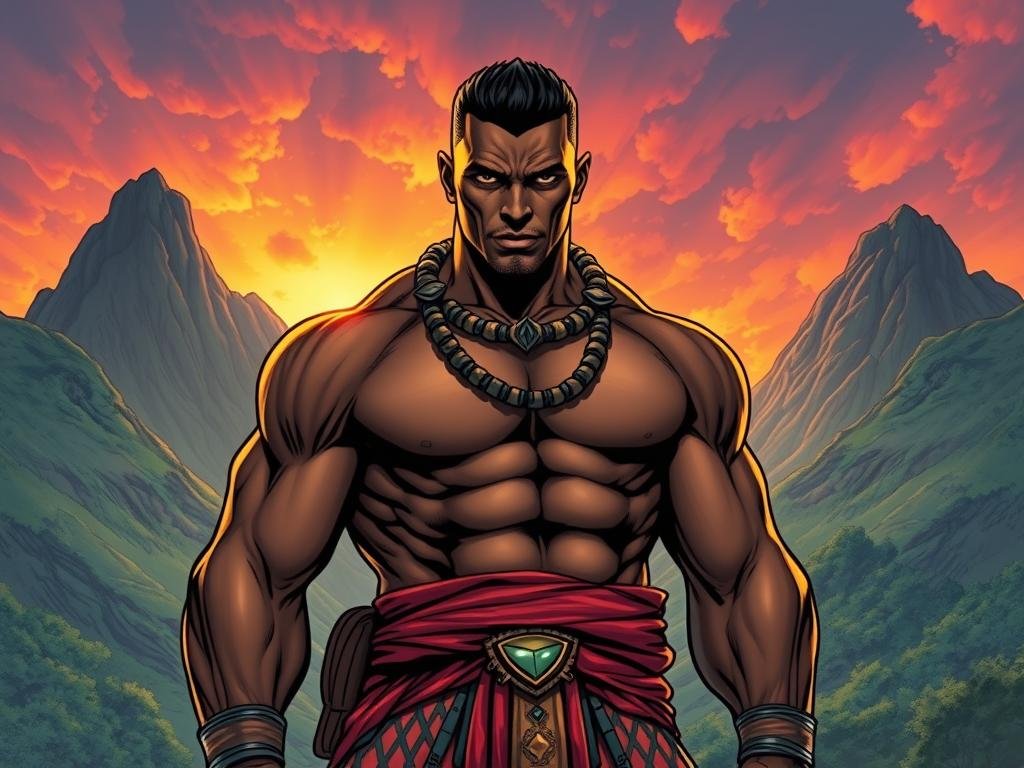
As fans continue to explore and debate the nuances of the Black Panther vs. Killmonger rivalry, it remains a vibrant and dynamic aspect of comic book culture.
The question of how to balance tradition and progress is one that resonates deeply, making this conflict a compelling subject for ongoing analysis.
Like many cultural phenomena, the Black Panther vs. Killmonger narrative has inspired fan art, cosplay, and fan fiction, further enriching the cultural landscape.
Beyond the Comics: Other Media Adaptations
From comics to cinema and beyond, the Black Panther vs. Killmonger conflict continues to resonate with audiences worldwide. This enduring appeal is evident in various media adaptations that have reinterpreted their rivalry.
The Marvel Cinematic Universe Interpretation
The MCU brought the Black Panther and Killmonger saga to life in “Black Panther” (2018), where Michael B. Jordan’s portrayal of Killmonger added depth to the character.
The film depicted Killmonger as the son of N’Jobu, killed by T’Chaka, leading to a complex revenge narrative. This interpretation highlighted the ideological clash between T’Challa and Killmonger, representing isolationism vs. global revolution.
Animation and Video Game Appearances
Animated series like “Avengers: Earth’s Mightiest Heroes” and “Marvel’s Avengers Assemble” have also explored the Black Panther/Killmonger conflict, often simplifying it for younger audiences while retaining core elements.
In video games such as “Marvel Contest of Champions” and “Marvel Future Fight,” both characters are playable, allowing gamers to engage with their rivalry directly. These adaptations have introduced the characters to new audiences and provided fresh storylines.
Key aspects of these adaptations include:
- Simplification of complex comic book narratives for broader appeal
- Introduction of unique storylines not present in the comics
- Enhanced character accessibility through interactive media
- Contribution to the characters’ popularity across different demographics
These media adaptations have not only expanded the Black Panther and Killmonger saga but have also enriched the Marvel universe, offering diverse perspectives on their epic conflict.
Fascinating Trivia About the Black Panther-Killmonger Rivalry
Exploring the Black Panther vs. Killmonger storyline uncovers a wealth of interesting behind-the-scenes information. The epic rivalry between these two characters is not just about their physical confrontations, but also about the rich history and symbolism associated with their conflict.
Behind-the-Scenes Facts
The creators of the Black Panther and Killmonger characters wove intricate details into their storylines.
For instance, Killmonger’s recovery of his father’s Wakandan Royal Ring served as a crucial sign of his heritage, symbolizing his claim to the Wakandan throne.
This element adds depth to the narrative, highlighting the significance of the ring as a symbol of power and identity.
Some other behind-the-scenes facts include the careful planning of the characters’ visual appearances and the thematic connections between different storylines. The designers and writers worked together to create a cohesive and engaging narrative.
| Character Element | Symbolism | Storyline Impact |
|---|---|---|
| Wakandan Royal Ring | Sign of heritage and power | Killmonger’s claim to the throne |
| Black Panther’s Suit | Technological advancement and protection | Enhanced combat capabilities |
| Killmonger’s Scars | Physical and emotional trauma | Motivation for revenge |
Easter Eggs and Hidden Details
The Black Panther vs. Killmonger storylines are filled with subtle references and callbacks that add layers to the narrative. For example, the comic book panels often contain hidden details that provide insight into the characters’ motivations and backstories. The
sign of Wakandan culture, appearing in various forms throughout the story.
Furthermore, certain visual motifs and design elements create thematic connections across different stories, enriching the overall narrative.
Fans of the series have come to appreciate these Easter eggs, which often connect the Black Panther vs. Killmonger rivalry to other parts of the Marvel universe, involving characters like the Black Panther.
Conclusion: The Enduring Legacy of Wakanda’s Greatest Conflict
The legacy of the Black Panther and Killmonger’s confrontation continues to shape the narrative of Wakanda. This epic struggle has not only captivated fans but also provided a rich tapestry for exploring complex themes such as power, identity, and tradition.
The rivalry between T’Challa and Erik Killmonger transcends typical superhero conflicts by delving into ideological battles that resonate deeply with audiences.
Their clash for the throne represents a struggle for the future of Wakanda, with each character embodying different paths that the nation could take.
This conflict has influenced both characters’ development, with T’Challa learning to balance his duty to the tradition of Wakanda with the need for progress, while Killmonger’s actions were driven by his own understanding of how to improve the way of life for Wakandans.
As we look to the future, the Black Panther vs. Killmonger saga continues to evolve in current and upcoming comics, films, and other media. This ongoing narrative not only keeps the characters relevant but also allows for continued exploration of the themes that their conflict represents.
In conclusion, the Black Panther and Killmonger’s rivalry is a testament to the depth and complexity of Marvel’s storytelling.
I invite you to explore more character analyses and comic book histories at Hero and Villain World, where you can delve deeper into the life and times of your favorite heroes and villains, and discover how their stories continue to captivate and inspire.
As the Marvel universe continues to expand, the rest of the characters’ stories remain a vital part of its fabric, ensuring that the legacy of Black Panther and Killmonger will rest on the foundation of a rich and vibrant narrative.
Frequently Asked Questions
The clash between T’Challa and Erik Killmonger has sparked intense debate among fans, and we’re here to answer some of the most pressing questions.
Q: Who is Erik Killmonger, and what’s his connection to Black Panther?
Erik Killmonger, also known as N’Jadaka, is a Wakandan exile and a significant adversary to Black Panther. His complex past and ideological differences drive the conflict between him and T’Challa, the king of Wakanda.
Q: What are the main differences between Killmonger and Black Panther’s views on Wakanda?
While T’Challa aims to maintain Wakanda’s isolationist tradition, Killmonger advocates for using Wakanda’s advanced technology to challenge global oppression and assert the nation’s power on the world stage.
Q: How do the comic book and film versions of Killmonger differ?
The comic book version of Erik Killmonger has a more nuanced backstory, while the film adaptation, portrayed by Michael B. Jordan, brings a new level of charisma and depth to the character, making him a compelling antagonist.
Q: What are the powers and abilities of Black Panther and Killmonger?
Black Panther derives his powers from the Heart-Shaped Herb and his access to advanced Wakandan technology. Killmonger, having also consumed the Herb, possesses similar enhanced abilities, making their confrontations intense and closely matched.
Q: What is the significance of the Black Panther vs. Killmonger rivalry?
This rivalry represents a clash between tradition and progress, as well as different visions for Wakanda’s future. It explores themes of identity, power, and responsibility, making it a compelling narrative within the Marvel universe.
Q: How has the Black Panther vs. Killmonger storyline been received by fans and critics?
The storyline has garnered significant attention and acclaim for its thought-provoking themes and the depth it adds to the Marvel universe. Both fans and critics have praised the complexity of the characters and their conflict.
Q: Where can I read more about the Black Panther and Killmonger comic book series?
You can explore various comic book storylines featuring Black Panther and Killmonger through Marvel’s official comic book database, digital platforms, or by collecting graphic novels that compile key story arcs.
Q: How does the Black Panther vs. Killmonger conflict relate to real-world issues?
The conflict touches on issues like colonialism, identity, and the responsibility that comes with power, making it a reflection of and commentary on contemporary societal debates.
FAQ
Q: What sparked the rivalry between T’Challa and Erik Killmonger?
A: The rivalry began due to their fundamentally different views on how to rule Wakanda and its resources. T’Challa wanted to maintain the nation’s isolationist tradition, while Killmonger sought to use Wakanda’s technology and powers to wage war and liberate oppressed people worldwide.
Q: How did the Dora Milaje factor into the battle between T’Challa and Killmonger?
A: The Dora Milaje, Wakanda’s all-female special forces, initially sided with T’Challa, their king. However, Killmonger’s charisma and ideology managed to sway some of them, creating an internal conflict within the group.
Q: What was the significance of the final battle between T’Challa and Killmonger?
A: The final battle was not just a physical confrontation but an ideological clash. It represented the struggle for the future of Wakanda and its people, with T’Challa advocating for a more cautious approach and Killmonger pushing for a more aggressive stance.
Q: How did Killmonger’s past influence his actions against T’Challa?
A: Killmonger’s past experiences, particularly his abandonment by his Wakandan uncle and his witnessing of oppression in the outside world, fueled his resentment towards T’Challa and the Wakandan monarchy, driving him to seek the throne.
Q: What role did the throne play in the conflict between T’Challa and Killmonger?
A: The throne symbolized the power and leadership of Wakanda. Both characters saw it as a means to achieve their goals, with T’Challa wanting to protect Wakanda’s traditions and Killmonger seeking to use its resources to change the world.
Q: In what ways did the battle between T’Challa and Killmonger reflect the broader themes of the Wakandan nation?
A: The battle represented the internal struggle within Wakanda regarding its identity, its place in the world, and how it should interact with other nations. It highlighted the tension between preserving tradition and embracing change.
